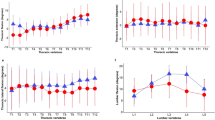Abstract
Objective:
Effects of obesity on trunk forward flexion motion in sitting and standing, and postural adaptations and hip joint moment for a standing work task.
Design:
Cross-sectional comparison of obese and normal weight groups.
Subjects:
Ten obese subjects (waist girth 121.2±16.8 cm, body mass index (BMI) 38.9±6.6 kg m−2) and 10 age- and height-matched normal weight subjects (waist girth 79.6±6.4 cm, BMI 21.7±1.5 kg m−2).
Methods:
Trunk motion during seated and standing forward flexion, and trunk posture, hip joint moment and hip-to-bench distance during a simulated standing work task were recorded.
Results:
Forward flexion motion of the thoracic segment and thoracolumbar spine was decreased for the obese group with no change in pelvic segment and hip joint motion. Obese subjects showed a more flexed trunk posture and increased hip joint moment and hip-to-bench distance for a simulated standing work task.
Conclusions:
Decreased range of forward flexion motion, differing effects within the trunk, altered posture during a standing work task and concomitant increases in hip joint moment give insight into the aetiology of functional decrements and musculoskeletal pain seen in obesity.
This is a preview of subscription content, access via your institution
Access options
Subscribe to this journal
Receive 12 print issues and online access
$259.00 per year
only $21.58 per issue
Buy this article
- Purchase on Springer Link
- Instant access to full article PDF
Prices may be subject to local taxes which are calculated during checkout
Similar content being viewed by others

References
Hsieh CJ, Pringle RK . Range of motion of the lumbar spine required for four activities of daily living. J Manip Physiol Ther 1994; 17: 353–358.
Larsson U, Mattsson E . Functional limitations linked to high body mass index, age and current pain in obese women. Int J Obes Relat Metab Disord 2001; 25: 893–899.
Escalante A, Lichtenstein MJ, Dhanda R, Cornell JE, Hazuda HP . Determinants of hip and knee flexion range: results from the San Antonio Longitudinal Study of Aging. Arthritis Care Res 1999; 12: 8–18.
Batti'e MC, Bigos SJ, Sheehy A, Wortley MD . Spinal flexibility and individual factors that influence it. Phys Ther 1987; 67: 653–658.
Gilleard W, Crosbie J, Smith R . Effect of pregnancy on trunk range of motion when sitting and standing. Acta Obstet Gynecol Scand 2002; 81: 1011–1020.
Paul JA, Salle H, Frings-Dresen MHW . Effect of posture on hip joint moment during pregnancy, while performing a standing task. Clin Biomech 1996; 11: 111–115.
O'Neil TW, McCloskey EV, Kanis JA, Bhalla AK, Reeve J, Reid DM et al. The distribution, determinants, and clinical correlates of vertebral osteophytosis: a population based survey. J Rheumatol 1999; 26: 842–848.
Peltonen M, Lindroos A, Torgerson J . Musculoskeletal pain in the obese: a comparison with a general population and long-term changes after conventional and surgical obesity treatment. Pain 2003; 104: 549–557.
Winter DA . Biomechanics and Motor Control of Human Movement. John Wiley & Sons: New York, 1990.
Hof A . Scaling gait data to body size. Gait Posture 1996; 4: 222–223.
Maffiulette N, Agosti F, Proietti M, Resnik M, LaFortuna C, Sartorio A . Postural instability of extremely obese individuals improves after a body weight reduction program entailing specific balance training. J Endocrinol Invest 2005; 28: 2–7.
Mirtz T, Green L . Is obesity a risk factor for low back pain? An example of using the evidence to answer a clinical question. Chiropra Osteopathy 2005; 13 doi:10.1186/1746-1340-13-2 http://www.chiroandosteo.com/content/13/1/2.
Boussenna M, Corlett E, Pheasant S . The relation between discomfort and postural loading at the joints. Ergonomics 1982; 25: 315–322.
Larsson U, Mattsson E . Influence of weight loss programmes on walking speed and relative oxygen cost (%VO2max) in obese women during walking. J Rehabil Med 2003; 35: 91–97.
Paul JA, Frings-Dresen MHW . Standing work posture compared in pregnant and non-pregnant conditions. Ergonomics 1994; 37: 1563–1575.
Proietto J . Can the obesity epidemic be stopped? Asia Pac J Clin Nutr 2005; 14 (Suppl): S32.
Paul JA, Frings-Dresen MHW, Salle H, Rozendal R . Pregnant women and working surface height and working surface areas for standing manual work. Appl Ergon 1995; 26: 129–133.
Acknowledgements
This project was supported by a Southern Cross University Research Grant.
Author information
Authors and Affiliations
Corresponding author
Rights and permissions
About this article
Cite this article
Gilleard, W., Smith, T. Effect of obesity on posture and hip joint moments during a standing task, and trunk forward flexion motion. Int J Obes 31, 267–271 (2007). https://doi.org/10.1038/sj.ijo.0803430
Received:
Revised:
Accepted:
Published:
Issue Date:
DOI: https://doi.org/10.1038/sj.ijo.0803430
Keywords
This article is cited by
-
Differences in spinal posture and mobility between adults with obesity and normal weight individuals
Scientific Reports (2023)
-
A multidimensional approach to wearability assessment of an electronic wrist bracelet for the criminal justice system
Fashion and Textiles (2022)
-
Overweight and smoking promote recurrent lumbar disk herniation after discectomy
European Spine Journal (2022)
-
Use of various obesity measurement and classification methods in occupational safety and health research: a systematic review of the literature
BMC Obesity (2018)
-
Central and peripheral fatigue development in the shoulder muscle with obesity during an isometric endurance task
BMC Musculoskeletal Disorders (2017)


